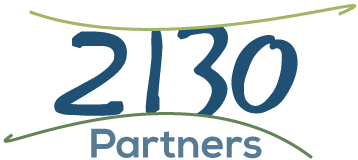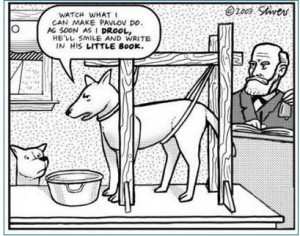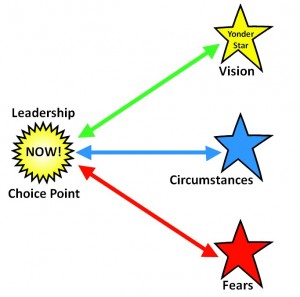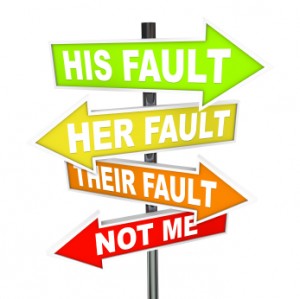 "How much wood would a woodchuck chuck if a woodchuck could chuck wood?" This old tongue twister is a light-hearted approach to something we have been noticing more and more recently. What we are seeing is a phenomenon of clients speaking in "woulds.” Instead of speaking in a direct and declarative way, e.g. “It’s time to deal with this issue, take action on this task, etc.," we are hearing people say “What I would say about that topic is…” It seems to have become a fairly common way to speak in meetings and such, yet it leaves me wondering what is actually going on with the speaker?
It seems very similar to when people speak about a personal experience using “you” to explain it. For example, “well, you know, when you’re cold and tired…” except they are speaking about their own hiking adventure or experience. Whether you are “speaking in woulds” or “speaking in yous,” in both cases you are subconsciously distancing yourself from your own experience and turning a valuable opportunity for real connection and sharing into just distant story or removed opinion.
"How much wood would a woodchuck chuck if a woodchuck could chuck wood?" This old tongue twister is a light-hearted approach to something we have been noticing more and more recently. What we are seeing is a phenomenon of clients speaking in "woulds.” Instead of speaking in a direct and declarative way, e.g. “It’s time to deal with this issue, take action on this task, etc.," we are hearing people say “What I would say about that topic is…” It seems to have become a fairly common way to speak in meetings and such, yet it leaves me wondering what is actually going on with the speaker?
It seems very similar to when people speak about a personal experience using “you” to explain it. For example, “well, you know, when you’re cold and tired…” except they are speaking about their own hiking adventure or experience. Whether you are “speaking in woulds” or “speaking in yous,” in both cases you are subconsciously distancing yourself from your own experience and turning a valuable opportunity for real connection and sharing into just distant story or removed opinion.
The issue for leaders is that if you are speaking in a distant or disconnected fashion your team and co-workers feel it and know it. In order to be able to follow a leader in a truly committed and positive way, teams need to feel some level of safety. (We know there are many leaders who are followed by using a bully stick and that’s not the type of leadership we are talking about here.)
If you are really going to lead you must declare yourself. You must be able to put a stake in the ground. This does not mean being aggressive, antagonistic or being a bully. It means being clear about your point-of-view and being able to articulate it clearly from a place of being open, present and connected with those to whom you are speaking.
Take a minute to self-observe. Have you been a “would-chuck?” When you hear a “what I would say…” come out of your mouth, what’s going on? What we believe is that it boils down to the level of safety within a group so how safe do you feel with the group you are in? How confident are you of your own authentic perspective on the matter? Are you sending up a “trial balloon” to see if it gets shot down? After all, if it does, it was only what you “would say,” not anything you really said with your own heart and soul and commitment behind it. No one would expect to hold you to a mere trial balloon would they?
To raise the stakes and accelerate the action in your conversations, try cleaning up your speaking by using “I” statements without “woulds” and other caveats. Say what you really mean with commitment behind it. You may notice the “pucker factor” goes up when you speak this way. So will the productivity and effectiveness of your interactions.
One word about self-observation. We all have to make it on our own 99% of the time, even if we have one or more great coaches and we’re regularly in courses and programs for personal development. This means, to gain the leverage we want in our leadership conversations, we will be self-coaching most of the time or just repeating our regular level of effectiveness. Self-coaching means listening to the words that come out of your mouth and noticing how they land with others. You must learn to recognize your impact and, as we have said before, “the emotional wake” you leave behind. (Credit again to Fierce, Inc. for the “emotional wake” terminology.)
When you can hear it/see it happening in the moment, only then will you actually have a real choice to shift. You will have a real moment to coach yourself to high leverage leadership.

 During a recent conversation with one of our CEO clients, I saw more deeply into something that I’ve been puzzling about for a long time that was both helpful and a bit entertaining for him. My puzzle has been ‘what makes it so hard for most of us to fully articulate and then share our real dreams with those around us? ‘
What came clear out of our conversation is that there is great personal risk in fully speaking a dream, even to yourself. Our histories, (which we fondly refer to metaphorically at 2130 Partners as “File Cabinets”), have lots of evidence stored in them about things that haven’t turned out, limiting beliefs, and circumstances that will prevent success. These “historical files” may well be aggregated under the section tab called “Impossible.”
During a recent conversation with one of our CEO clients, I saw more deeply into something that I’ve been puzzling about for a long time that was both helpful and a bit entertaining for him. My puzzle has been ‘what makes it so hard for most of us to fully articulate and then share our real dreams with those around us? ‘
What came clear out of our conversation is that there is great personal risk in fully speaking a dream, even to yourself. Our histories, (which we fondly refer to metaphorically at 2130 Partners as “File Cabinets”), have lots of evidence stored in them about things that haven’t turned out, limiting beliefs, and circumstances that will prevent success. These “historical files” may well be aggregated under the section tab called “Impossible.” In a workshop the other day, 2130 Partners’ co-founder, Suzanne Frindt, (who is also my wife), usedthe term “Lazy Labels” to capture the instant, automatic, and unexamined statements many, if not all of us make on a fairly regular basis. These statements could also be called “knee jerk reactions.” In this highly charged season of political sound-bites, such Lazy Labels seem to be flying everywhere! What we notice about “Lazy Labels” is that they seem to be a convenient way to suppress complex topics you don’t actually understand, don’t want to examine, or have “already made up your mind about.” The issue with this is that their use diminishes your effectiveness as a vision-focused leader. Let me explain.
Lazy Labels often have the effect of “shutting things down” like diagloue and conversations. If you stop dialogue, healthy inquiry, and curiosity-based listening with one of those quick labels/statements, you and those around you, will never learn more about each others’ knowledge, perspectives and feelings. In fact your brain has a mechanism to be sure you don’t learn anything that disagrees with your Lazy Label. You won’t be learning anything new about the subject at all. You will only see evidence that agrees with you. As we have written about often, we believe this is the era of collaborative leadership. We need each other’s skills, competencies, knowledge and perspective now more than ever, so shutting yourself and/or your team members down is dangerous.
In a workshop the other day, 2130 Partners’ co-founder, Suzanne Frindt, (who is also my wife), usedthe term “Lazy Labels” to capture the instant, automatic, and unexamined statements many, if not all of us make on a fairly regular basis. These statements could also be called “knee jerk reactions.” In this highly charged season of political sound-bites, such Lazy Labels seem to be flying everywhere! What we notice about “Lazy Labels” is that they seem to be a convenient way to suppress complex topics you don’t actually understand, don’t want to examine, or have “already made up your mind about.” The issue with this is that their use diminishes your effectiveness as a vision-focused leader. Let me explain.
Lazy Labels often have the effect of “shutting things down” like diagloue and conversations. If you stop dialogue, healthy inquiry, and curiosity-based listening with one of those quick labels/statements, you and those around you, will never learn more about each others’ knowledge, perspectives and feelings. In fact your brain has a mechanism to be sure you don’t learn anything that disagrees with your Lazy Label. You won’t be learning anything new about the subject at all. You will only see evidence that agrees with you. As we have written about often, we believe this is the era of collaborative leadership. We need each other’s skills, competencies, knowledge and perspective now more than ever, so shutting yourself and/or your team members down is dangerous.
 In the 1920s Ivan Pavlov conducted a series of very famous experiments in which he taught dogs to salivate at the ringing of a bell. If PDAs had been invented, he could have taught the dog to salivate when his cell phone received a call, email or text. He might have even taught the dog to bark so he would never miss an “incoming!”
In the 1920s Ivan Pavlov conducted a series of very famous experiments in which he taught dogs to salivate at the ringing of a bell. If PDAs had been invented, he could have taught the dog to salivate when his cell phone received a call, email or text. He might have even taught the dog to bark so he would never miss an “incoming!”




 As we discuss comfort zones, set points, etc. we want to be clear that this is not a piece about people who plod along and move slowly or people who seem risk averse. If you are a fast-paced, “go go go” type of person that is your comfort zone. What if you had to slow down, be more reflective, bring your energy “down and in” instead of being an “up and out” kind of person? What if you had to take on a meditation practice? Would you still be in your comfort zone? What if you are a thrill seeker and look for ways to “push the envelope” all the time? What would happen if you lived a more mundane existence and had to experience the ordinary? Would you still be in your comfort zone?
As we discuss comfort zones, set points, etc. we want to be clear that this is not a piece about people who plod along and move slowly or people who seem risk averse. If you are a fast-paced, “go go go” type of person that is your comfort zone. What if you had to slow down, be more reflective, bring your energy “down and in” instead of being an “up and out” kind of person? What if you had to take on a meditation practice? Would you still be in your comfort zone? What if you are a thrill seeker and look for ways to “push the envelope” all the time? What would happen if you lived a more mundane existence and had to experience the ordinary? Would you still be in your comfort zone?



 Many business owners, entrepreneurs, and professionals are “visionaries” – independent minded self-starters with lots of creativity and ideas. They often have a deep belief and confidence in their own point-of-view. If you are one of these people and have been successful, these traits have served you well. The challenge is that, at some point, to increase your level of productivity and success, it will take a team around you.
“My Team Are My Hands and Feet.” – Do you hire people as extensions of yourself? Meaning, you want them to just execute what you have in mind without questions - just to be an “extra pair of hands and feet.” If you have not developed the ability to clearly articulate your vision and goals in a way that is inclusive, everyone else is left wondering and waiting for you next set of instructions. This reinforces your sense of “I should just do it myself,” or, “if I could just do it myself.”
Many business owners, entrepreneurs, and professionals are “visionaries” – independent minded self-starters with lots of creativity and ideas. They often have a deep belief and confidence in their own point-of-view. If you are one of these people and have been successful, these traits have served you well. The challenge is that, at some point, to increase your level of productivity and success, it will take a team around you.
“My Team Are My Hands and Feet.” – Do you hire people as extensions of yourself? Meaning, you want them to just execute what you have in mind without questions - just to be an “extra pair of hands and feet.” If you have not developed the ability to clearly articulate your vision and goals in a way that is inclusive, everyone else is left wondering and waiting for you next set of instructions. This reinforces your sense of “I should just do it myself,” or, “if I could just do it myself.” “What Are You Really Good At?” – No matter how gifted, talented, and intelligent you are, you still have a “zone of excellence,” (as author Gay Hendricks would say), and zones of competence and incompetence. Your highest and best use is your zone of excellence.
“What Are You Really Good At?” – No matter how gifted, talented, and intelligent you are, you still have a “zone of excellence,” (as author Gay Hendricks would say), and zones of competence and incompetence. Your highest and best use is your zone of excellence. In the process of growing up and becoming a successful leader, you most likely put together a set of well-developed values, beliefs, experiences, and capacities. You have probably done well at suppressing your emotions and demonstrating your rational thinking. Being successful means your mix has served you well; you have been rewarded, “bonused,” and encouraged along the way. You have probably learned to rely on the way you interact, solve problems, and produce results to the point where the basis of your thinking, (your “paradigm”), is now instant, automatic, and unexamined.
To paraphrase the
In the process of growing up and becoming a successful leader, you most likely put together a set of well-developed values, beliefs, experiences, and capacities. You have probably done well at suppressing your emotions and demonstrating your rational thinking. Being successful means your mix has served you well; you have been rewarded, “bonused,” and encouraged along the way. You have probably learned to rely on the way you interact, solve problems, and produce results to the point where the basis of your thinking, (your “paradigm”), is now instant, automatic, and unexamined.
To paraphrase the  leadership,” and that means the Peter Principle is “in effect.” To continue to lead successfully, you will be required to think in new ways and benefit from the thoughts and perspectives of others. In other words, cherished self-reliance becomes obsolete. Collaboration, inclusion, openness, the ability to continue learning, respect of others’ skills, expecting others to contribute - these are the traits that are critical to develop.
leadership,” and that means the Peter Principle is “in effect.” To continue to lead successfully, you will be required to think in new ways and benefit from the thoughts and perspectives of others. In other words, cherished self-reliance becomes obsolete. Collaboration, inclusion, openness, the ability to continue learning, respect of others’ skills, expecting others to contribute - these are the traits that are critical to develop. This may seem like a funny question, but do you know the answer? Are you using all of your intelligence? We don’t mean “business intelligence” in the sense of consumer data, research and business results. We are talking about your own personal intelligence. You probably believe you “give it your all” and use all of your capacities and capabilities – but are you sure?
This may seem like a funny question, but do you know the answer? Are you using all of your intelligence? We don’t mean “business intelligence” in the sense of consumer data, research and business results. We are talking about your own personal intelligence. You probably believe you “give it your all” and use all of your capacities and capabilities – but are you sure?
 We can all think of examples of stories where people followed a gut instinct and it was either critical to their survival, or it changed their life, or drove them to make an important business decision. When people are tuned in to that gut information, and they are asked how they knew something or why they did what they did, the response they give is, “I just knew,” and we can tell by the emphasis that the knowing came from a deep and solid place. Being able to tap into our deep-seated inner knowing is something fundamentally human that our culture does not overtly value highly.
We can all think of examples of stories where people followed a gut instinct and it was either critical to their survival, or it changed their life, or drove them to make an important business decision. When people are tuned in to that gut information, and they are asked how they knew something or why they did what they did, the response they give is, “I just knew,” and we can tell by the emphasis that the knowing came from a deep and solid place. Being able to tap into our deep-seated inner knowing is something fundamentally human that our culture does not overtly value highly. (This post is an edited version of an article by Suzanne Mayo Frindt. To get the complete text
(This post is an edited version of an article by Suzanne Mayo Frindt. To get the complete text  How Can We Develop a Learning Culture?
There are many books and articles about learning organizations including work by Senge
How Can We Develop a Learning Culture?
There are many books and articles about learning organizations including work by Senge In
In  If you take this on and find yourself uncomfortable, make note of what your mind is saying is going to happen to you or how your internal dialogue is criticizing you. Use your self-awareness skills and you will likely find what’s stopping you is a limiting belief. Once identified, you can go to work on letting go of it. Check out
If you take this on and find yourself uncomfortable, make note of what your mind is saying is going to happen to you or how your internal dialogue is criticizing you. Use your self-awareness skills and you will likely find what’s stopping you is a limiting belief. Once identified, you can go to work on letting go of it. Check out 
 Fast forward back to today with this historical perspective and we can see that everything we take for granted as we do business today was originally invented by someone to facilitate trade, which in turn was driven by thousands of entrepreneurs in all regions where they were allowed to operate and were not taxed out of existence. Modern management is just a relatively late development to solve the “recent” problems of large operations scattered over great geographic areas and allow them to continue to facilitate trade and lower its cost. Much of the value of that management has been in gathering, organizing, and dispensing information needed by large numbers of people in far-flung operations to get their work done and make the transactions happen.
Fast forward back to today with this historical perspective and we can see that everything we take for granted as we do business today was originally invented by someone to facilitate trade, which in turn was driven by thousands of entrepreneurs in all regions where they were allowed to operate and were not taxed out of existence. Modern management is just a relatively late development to solve the “recent” problems of large operations scattered over great geographic areas and allow them to continue to facilitate trade and lower its cost. Much of the value of that management has been in gathering, organizing, and dispensing information needed by large numbers of people in far-flung operations to get their work done and make the transactions happen.
 Change is possible and change takes work.Whether a leader changes or not, energy is being expended. It takes energy to keep patterns in place when they aren’t working and there is a state of resistance. We call that ‘friction and waste,’ a subject we address in our blog posts on Lean Thinking. It takes energy to make changes. There is a cost either way. The question is – where does a leader “pay up?”
Change is possible and change takes work.Whether a leader changes or not, energy is being expended. It takes energy to keep patterns in place when they aren’t working and there is a state of resistance. We call that ‘friction and waste,’ a subject we address in our blog posts on Lean Thinking. It takes energy to make changes. There is a cost either way. The question is – where does a leader “pay up?”